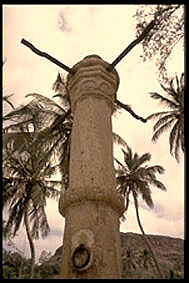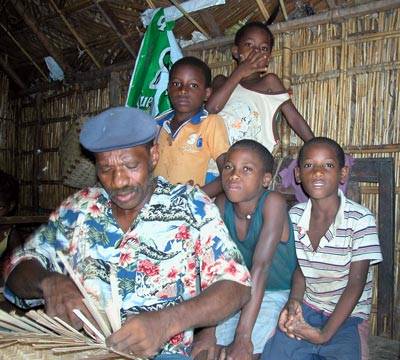|
Espinho Branco
Espinho Branco is a village in the northern part of the island of Santiago, Cape Verde. In 2010 its population was 869. It is situated near the coast, 5 km northwest of Calheta de São Miguel. Espinho Branco is known for its community of Rabelados The Rabelados (from the Portuguese ''rebelados'', "rebels") are a religious community primarily found in the interior of the island of Santiago of Cape Verde. They were among the groups which revolted against the liturgical reforms of the Catholic ..., a group of people who opposed reforms of the Catholic church and maintain a traditional way of life. Câmara Municipal de São Miguel References {{Subdivisions of Santiago, Cape Verde São Miguel, Cape Verde[...More Info...] [...Related Items...] OR: [Wikipedia] [Google] [Baidu] |
Santiago, Cape Verde
Santiago (Portuguese language, Portuguese for “James, son of Zebedee, Saint James”) is the largest island of Cape Verde, its most important agricultural centre and home to half the nation's population. Part of the Sotavento Islands, it lies between the islands of Maio, Cape Verde, Maio ( to the east) and Fogo, Cape Verde, Fogo ( to the west). It was the first of the islands to be settled: the town of Ribeira Grande (now Cidade Velha and a UNESCO World Heritage Site) was founded in 1462. Santiago is home to the nation's capital city of Praia. History The eastern side of the nearby island of Fogo, Cape Verde, Fogo collapsed into the ocean 73,000 years ago, creating a tsunami high which struck Santiago. In 1460, António de Noli became the first to visit the island. Da Noli settled at ''Ribeira Grande'' (now Cidade Velha) with his family members and Portuguese from Algarve and Alentejo in 1462. [...More Info...] [...Related Items...] OR: [Wikipedia] [Google] [Baidu] |
Cape Verde
Cape Verde or Cabo Verde, officially the Republic of Cabo Verde, is an island country and archipelagic state of West Africa in the central Atlantic Ocean, consisting of ten volcanic islands with a combined land area of about . These islands lie between west of Cap-Vert, the westernmost point of continental Africa. The List of islands of Cape Verde, Cape Verde islands form part of the Macaronesia ecoregion, along with the Azores, the Canary Islands, Madeira and the Savage Isles. The Cape Verde archipelago was uninhabited until the 15th century, when Portuguese Empire, Portuguese explorers colonized the islands, establishing one of the first Age of Discovery, European settlements in the tropics. Due to its strategic position, Cape Verde became a significant location in the Atlantic slave trade, transatlantic slave trade during the 16th and 17th centuries. The islands experienced economic growth during this period, driven by their role by the rapid emergence of merchants, priva ... [...More Info...] [...Related Items...] OR: [Wikipedia] [Google] [Baidu] |
Calheta De São Miguel
Calheta de São Miguel is a cityCabo Verde, Statistical Yearbook 2015 Instituto Nacional de Estatística, p. 32-33 in the northern part of the island of , . In 2010 its population was 3,175. It is on the east coast, north of the capital Praia
[...More Info...] [...Related Items...] OR: [Wikipedia] [Google] [Baidu] |
Rabelados
The Rabelados (from the Portuguese ''rebelados'', "rebels") are a religious community primarily found in the interior of the island of Santiago of Cape Verde. They were among the groups which revolted against the liturgical reforms of the Catholic Church introduced in the 1940s, isolating themselves from the rest of society. History In the 1940s the Catholic Church sent various priests to Cape Verde to replace local priests and introduce alterations in the celebrations of the Mass and other religious customs, particularly religious education. Some groups amongst the population rebelled against these alterations. Known in the Cape Verdean Creole Cape Verdean Creole is a Portuguese-based creole languages, Portuguese-based creole language spoken on the islands of Cape Verde. It is the native creole language of virtually all Cape Verdeans and is used as a second language by the Cape Verd ... language as ''rabelados'' ("rebels"), they came to practice their earlier traditions ... [...More Info...] [...Related Items...] OR: [Wikipedia] [Google] [Baidu] |
São Miguel, Cape Verde
São Miguel is a ''concelho'' (municipality) of Cape Verde. It is situated in the northeastern part of the island of Santiago. Its seat is the city Calheta de São Miguel. Its population was 15,648 at the 2010 census, and its area is 77.4 km2. The municipality was created in 1996, when a parish of the older Municipality of Tarrafal was separated to become the Municipality of São Miguel. p. 71 Subdivisions The municipality consists of one ''freguesia
(), usually translated as "parish" or "civil parish", is the third-level administrative subdivision of Portugal, ...
[...More Info...] [...Related Items...] OR: [Wikipedia] [Google] [Baidu] |

